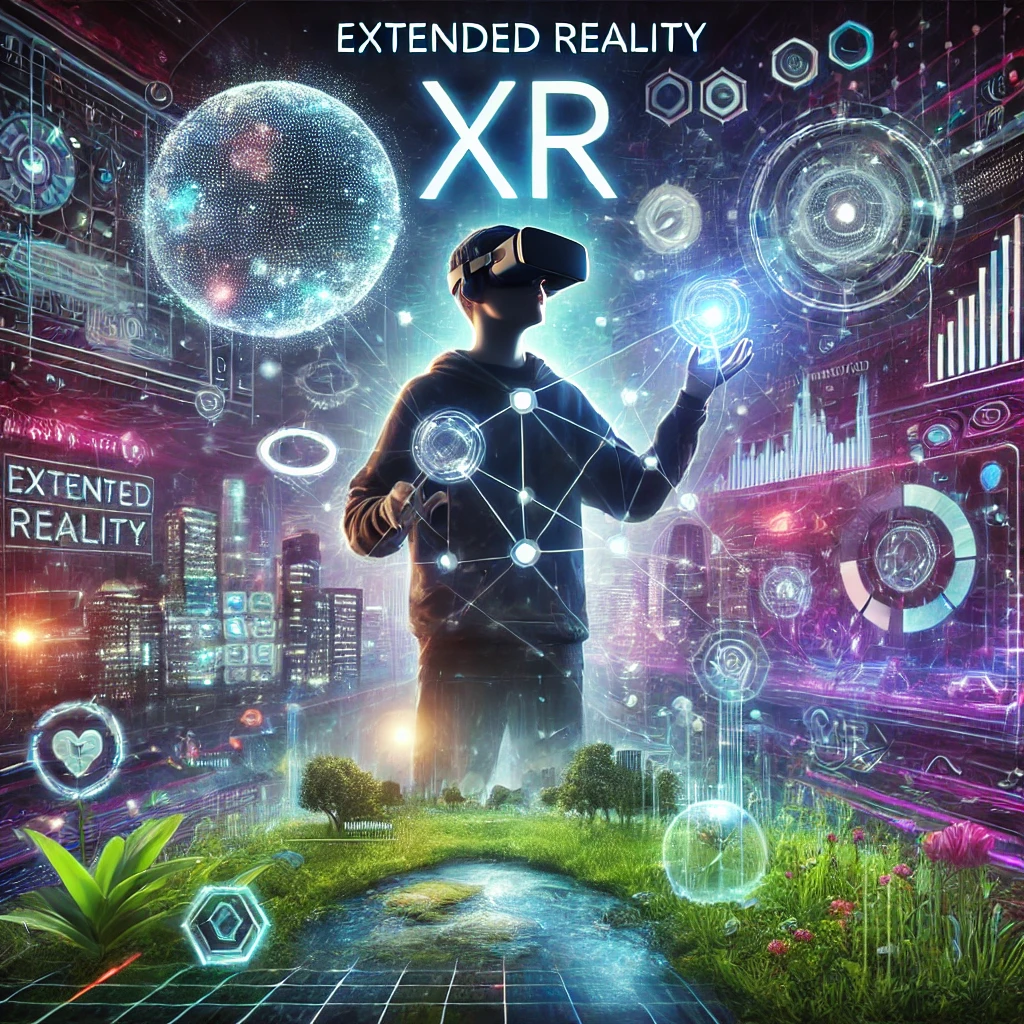In the ever-evolving digital world, Extended Reality (XR) is a groundbreaking technology that merges the physical and digital realms. XR encompasses a range of immersive experiences, including Virtual Reality (VR), Augmented Reality (AR), and Mixed Reality (MR), all of which have reshaped the way we interact with digital content.
XR offers immense potential across multiple sectors, from entertainment and education to healthcare and manufacturing. By seamlessly blending virtual elements with the real world, XR provides new ways of experiencing, interacting, and understanding complex environments and processes.
In this article, we’ll dive deep into what Extended Reality is, how it works, and its applications across various industries.
What is Extended Reality?
Extended Reality (XR) is an umbrella term that refers to immersive technologies that combine the physical world with digital or virtual elements. XR serves as a collective term for technologies such as VR, AR, and MR. Each of these technologies has unique features, but they all share the goal of enhancing human interaction with digital environments.
- Virtual Reality (VR): VR is a fully immersive digital experience where the user is placed inside a virtual environment, typically through a headset or specialized equipment. It completely replaces the physical world, offering a simulated reality that can be interactive and dynamic.
- Augmented Reality (AR): AR overlays digital elements onto the physical world. Users can still interact with their real-world surroundings while experiencing additional digital content, such as 3D objects, animations, or information displayed on screens or via AR glasses.
- Mixed Reality (MR): MR combines elements of both VR and AR, allowing digital objects to not only be overlaid on the real world but also interact with it in real-time. MR enables the user to interact with both the physical and digital worlds simultaneously, providing a more seamless experience than AR.
Together, VR, AR, and MR form the broader concept of Extended Reality, which is transforming industries across the globe by providing new ways to visualize, experience, and manipulate digital content in real time.
How Does Extended Reality Work?
Extended Reality technologies rely on a combination of software, hardware, and sensors to create an immersive experience. Here’s an overview of how XR technologies function:
- Hardware: XR technologies often use devices such as headsets, smart glasses, motion sensors, and controllers. These devices allow users to interact with and experience the virtual or augmented world. For example, VR headsets such as the Oculus Rift or HTC Vive create fully immersive experiences by blocking out the physical world, while AR devices like Microsoft HoloLens overlay digital elements onto the real world.
- Software: XR software is responsible for creating the environments and experiences that users interact with. For VR, this involves simulating an entire virtual world. For AR and MR, software uses advanced algorithms to recognize real-world objects and add digital components accordingly.
- Sensors and Tracking: To make the experience more realistic and interactive, XR technologies use motion tracking sensors, cameras, and depth sensors. These tools detect the user’s movements, gestures, and even eye gaze, allowing for real-time adjustments and interactions within the virtual environment.
- Interaction: XR experiences rely heavily on user interaction. Users can manipulate the digital environment using devices like controllers, hand gestures, or voice commands. This interaction provides users with the ability to explore, manipulate, and engage with the virtual or augmented world in dynamic and creative ways.
Applications of Extended Reality
XR technologies have found applications across a wide range of industries, revolutionizing the way people work, learn, play, and interact with the world. Here’s a look at some of the sectors where XR is making the biggest impact:
1. Gaming and Entertainment
- Virtual Reality has been particularly popular in gaming, offering immersive experiences where players can physically move, interact with environments, and experience gaming worlds in ways that were not possible with traditional gaming consoles. Popular VR games like Beat Saber and Half-Life: Alyx have captured the attention of millions, setting new standards for what immersive gaming can achieve.
- Augmented Reality games like Pokémon GO have integrated the real world with virtual elements, allowing players to explore their surroundings while interacting with digital objects. This merging of physical and digital play has taken gaming to new heights, engaging users in ways never imagined before.
- Mixed Reality is pushing the boundaries of entertainment even further, allowing for interactive storytelling and immersive movie experiences, where digital and real elements coexist.
2. Education and Training
- XR is changing how students learn and how professionals are trained. VR is used to create realistic simulations, allowing students to immerse themselves in subjects such as history, science, and engineering. For example, medical students can use VR to simulate surgeries or anatomy lessons, while history students can experience virtual field trips to ancient civilizations.
- AR in education enhances textbooks and educational tools with interactive content, enabling students to visualize complex topics and engage with learning materials in new ways. Apps that overlay digital information on real-world objects can make learning more engaging and intuitive.
- MR is utilized in training environments where real-world and virtual elements interact. For instance, manufacturers use MR to train workers by providing hands-on instructions with real-time feedback.
3. Healthcare
- Virtual Reality is used in healthcare for therapy, pain management, and medical training. For instance, VR has been proven to help reduce pain during procedures, providing a distraction and immersive environment that helps patients relax.
- Augmented Reality is employed in surgeries, allowing surgeons to visualize critical data, such as CT scans or MRI results, overlaid on the patient’s body in real-time. This assists in more accurate and efficient procedures.
- Mixed Reality is used in physical rehabilitation, where patients interact with both real-world objects and virtual environments to improve mobility, coordination, and strength.
4. Retail and E-Commerce
- Augmented Reality is revolutionizing the retail industry by providing virtual try-ons for clothing, accessories, and even furniture. AR apps allow consumers to visualize how products will look in their homes or on their bodies before making a purchase.
- Virtual Reality has the potential to transform e-commerce, allowing customers to shop in fully immersive virtual stores, interacting with products as if they were physically present.
5. Manufacturing and Industry
- Mixed Reality is enhancing the manufacturing process by enabling workers to receive real-time instructions and feedback while interacting with machinery and equipment. MR allows for virtual overlays to be displayed on physical machines, guiding employees through complex tasks and minimizing errors.
6. Real Estate
- Virtual Reality is changing how real estate is bought and sold. Potential buyers can take virtual tours of properties without ever visiting them in person. This is particularly useful for long-distance transactions, saving time and resources.
- Augmented Reality is used to overlay design options or renovations on existing properties, helping clients visualize potential changes before making decisions.
The Future of Extended Reality
The future of Extended Reality looks incredibly promising. As technology continues to advance, we can expect more sophisticated, immersive, and accessible XR experiences. The integration of artificial intelligence (AI), 5G networks, and improved hardware will only accelerate XR adoption across industries. With the rapid expansion of XR’s capabilities, we are witnessing a new era of digital transformation, where reality is extended beyond what we previously thought possible.
Conclusion
Extended Reality (XR) is no longer just a futuristic concept; it is here, shaping the present and revolutionizing various industries. Whether through Virtual Reality, Augmented Reality, or Mixed Reality, XR technologies offer unprecedented experiences that enhance learning, entertainment, healthcare, retail, and more. As these technologies continue to evolve, XR will undoubtedly play a crucial role in transforming how we interact with the digital world.
At Canadian Updates, we are committed to providing the latest insights on emerging technologies, including XR, and how they’re impacting our daily lives.





